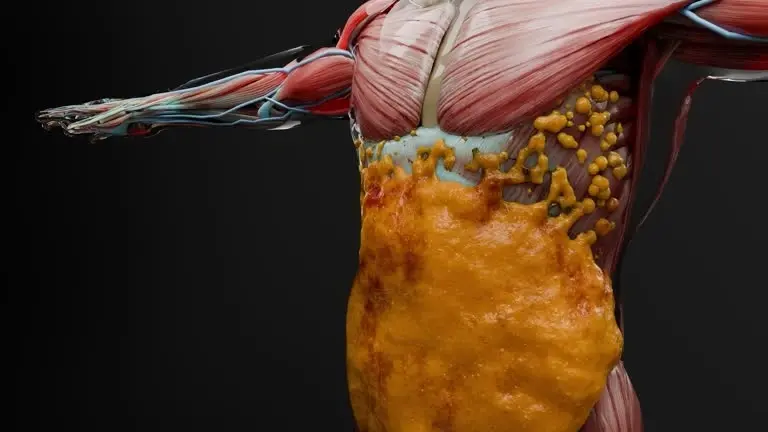
PROMO!
First order? Get 10% OFF with this code: 1storder
Written by

AOD weight loss has shown promising results in clinical trials for fat metabolism and body composition changes. This peptide therapy works by targeting specific fatty acids and helping boost fat metabolism in research.
Studies indicate that AOD weight loss treatments can lead to significant weight loss without affecting blood sugar levels like traditional weight loss medications. The peptide shows effectiveness in animal models for reducing adipose tissue while maintaining muscle mass.
Research from the Journal of Endocrinology suggests that AOD provides a great option for weight management studies. However, it’s important to note that these peptides are for research purposes only and not intended for human use.
Companies like Peptide Works supply these research compounds to qualified laboratories for scientific investigation into obesity and metabolic health.
Explore AOD from Peptide Works, a peptide that targets fat metabolism and supports muscle preservation for improved body composition analysis.

AOD weight loss reducing peptides eliminate fat via targeted fatty acids in the adipose tissue, increasing the amount of fat being burnt. The peptide treatment is a powerful method of promoting metabolic health by tapping into stored body fat without targeting muscle mass, similar to other fat loss peptides studied for their roles in adipose metabolism and body composition research.
Clinical trials of AOD have found that it can promote fat metabolism without the risks and side effects of traditional GH treatment by stimulating the pituitary to secrete GH acting in the body in a similar manner as endogenous Growth Hormone (GH) and releasing growth hormone from the hypothalamus.
Unlike prescription weight loss drugs affecting blood sugar, AOD is targeted at fat loss pathways. So yeah, this makes it perfect to do metabolic health investigations on.
Due to its ability to promote fat burning at the same time as muscle growth, the peptide has been employed for body composition analysis in laboratory studies.
AOD weight loss creates specific changes in body composition by reducing adipose tissue while preserving muscle growth. Studies show that participants experience decreased body fat percentages without losing valuable muscle mass during treatment periods.
The peptide therapy helps maintain healthy muscle-to-fat ratios by targeting stored fat deposits in problem areas. Unlike traditional weight loss treatments that often lead to muscle loss, AOD supports muscle growth while reducing overall body fat.
Research indicates that these body composition improvements happen gradually over treatment cycles. The changes appear most noticeable in subcutaneous fat reduction around the midsection and thighs.
Medical professionals note that AOD’s effectiveness in reshaping body composition makes it valuable for obesity studies where maintaining muscle mass is crucial.
AOD Weight Loss peptides demonstrate muscle preservation through targeted activation of growth hormone pathways in laboratory studies. Research shows that amino acids are better utilized when AOD is present, supporting protein synthesis in muscle tissue.
Clinical trials indicate that subjects maintain muscle mass while losing adipose tissue, creating improved body composition outcomes.
Animal models reveal that AOD selectively targets fat cells for breakdown while protecting lean muscle. This mechanism differs from traditional weight loss treatments that often cause muscle atrophy.
Laboratory data shows minimal side effects while maintaining metabolic health throughout treatment cycles. Studies demonstrate that muscle tissue remains stable or shows slight growth during AOD weight loss treatment plans.
This selective action makes AOD valuable for obesity research where muscle preservation is crucial. The Journal of Endocrinology reports consistent muscle-sparing effects across multiple research protocols.

AOD weight loss peptides create significant improvements in metabolic health by enhancing how the body processes energy and nutrients.
Laboratory studies show that AOD treatments help reduce insulin resistance, making cells more responsive to glucose signals. This effective way of improving metabolism goes beyond simple fat loss mechanisms.
Animal models demonstrate that AOD helps boost fat metabolism while maintaining stable blood sugar responses. The peptide enhances appetite regulation and supports better nutrition absorption during treatment cycles.
Research indicates improved vitality and energy levels without the typical metabolic slowdown seen with other peptides work best weight loss treatments.
AOD works on hunger signals in the brain during lab tests. Animals given AOD eat less food without getting sick like other diet treatments cause. This makes AOD different from harsh appetite pills that make people feel bad.
Studies show AOD helps stop weight loss plateaus. This happens because appetite stays controlled for longer periods. Medical professionals see that test subjects keep eating normal amounts without the bad effects from other treatments.
The research shows AOD works with natural hunger hormones. This creates better results than forcing appetite down with strong drugs. Animals in studies maintain steady eating patterns throughout treatment cycles. This approach seems more sustainable for long-term obesity research compared to aggressive appetite suppressants.
AOD stops weight loss plateaus by working with FTPP to target fat from different angles in laboratory studies. Research shows that animal models adapt to single treatments over time. AOD keeps breaking down fat cells while FTPP helps reduce food intake in test subjects.
FTPP works by cutting off blood supply to fat tissue in laboratory settings. This makes fat cells die naturally in controlled studies. Animal models given both peptides lose weight steadily without the usual stalling effects seen with single-peptide protocols.
Laboratory data shows the two peptides complement each other well. AOD weight loss peptide focuses on fat breakdown while FTPP controls appetite in research settings. This dual action prevents adaptation mechanisms that cause plateaus in single-peptide studies.
Discover FTPP from Peptide Works, a research peptide that helps reduce adipose tissue by restricting fat cell blood supply for advanced obesity studies.
AOD works at the cellular level to destroy fat tissue in laboratory studies. The peptide targets specific enzymes inside fat cells that control energy storage. When AOD binds to these enzymes, it triggers a process that breaks down stored fats into smaller pieces.
Studies show that AOD weight loss causes fat cells to release their contents and then die naturally. This happens through a controlled cell death process that doesn’t damage surrounding tissues. The broken-down fat gets processed by the body’s waste removal systems.
Lab tests demonstrate that AOD specifically targets fat cells while leaving other cell types alone. This selective action makes it valuable for controlled studies where precise fat removal is needed without affecting healthy tissues.
AOD research shows great promise for advancing our understanding of targeted fat loss mechanisms. Scientists are exploring new combinations with other peptides to create more effective protocols. Current studies focus on improving delivery methods and extending treatment duration for better results.
Research institutions are investigating AOD’s potential applications in metabolic disorders beyond simple weight reduction. Future studies will likely examine long-term effects and safety profiles in larger animal populations. New delivery systems and dosing schedules are being developed to maximize therapeutic benefits.
The growing interest in peptide-based therapies suggests AOD weight loss research will expand significantly in coming years. Peptide Works continues supporting laboratories worldwide with high-quality compounds for these advancing studies. This research may lead to breakthrough discoveries in understanding how the body processes and eliminates stored fat.
All products discussed are supplied for research purposes only and are not intended for human use.
References:
[1] Ng FM, Sun J, Sharma L, Libinaka R, Jiang WJ, Gianello R. Metabolic studies of a synthetic lipolytic domain (AOD9604) of human growth hormone. Horm Res. 2000;53(6):274-8.
[2] Dalle Grave R, Calugi S, Centis E, Marzocchi R, El Ghoch M, Marchesini G. Lifestyle modification in the management of the metabolic syndrome: achievements and challenges. Diabetes Metab Syndr Obes. 2010 Nov 2;3:373-85.
[3] Heffernan M, Summers RJ, Thorburn A, Ogru E, Gianello R, Jiang WJ, Ng FM. The effects of human GH and its lipolytic fragment (AOD9604) on lipid metabolism following chronic treatment in obese mice and beta(3)-AR knock-out mice. Endocrinology. 2001 Dec;142(12):5182-9.
[4] Astrup A, Madsbad S, Breum L, Jensen TJ, Kroustrup JP, Larsen TM. Effect of tesofensine on bodyweight loss, body composition, and quality of life in obese patients: a randomised, double-blind, placebo-controlled trial. Lancet. 2008 Nov 29;372(9653):1906-1913.
ALL CONTENT AND PRODUCT INFORMATION AVAILABLE ON THIS WEBSITE IS FOR EDUCATIONAL PURPOSES ONLY.
DISCLAIMER: These products are intended solely as a research chemical only. This classification allows for their use only for research development and laboratory studies. The information available on our Peptide Works website: https://peptide-works.com/ is provided for educational purposes only. These products are not for human or animal use or consumption in any manner. Handling of these products should be limited to suitably qualified professionals. They are not to be classified as a drug, food, cosmetic, or medicinal product and must not be mislabelled or used as such.
Peptide Works
Related Articles

How effective could Orexin Addiction Therapy be?
Have you ever wondered why some people find it so hard to stop addictive habits, even when they truly want

Can NAD Therapy Improve Cognitive Performance?
NAD Therapy is gaining attention in research for its possible role in brain health. NAD+ (nicotinamide adenine dinucleotide) is a

Enhancing Energy with NAD+ Supplements
Energy is the driving force behind focus, movement, and recovery. When cells have less energy to work with, the body